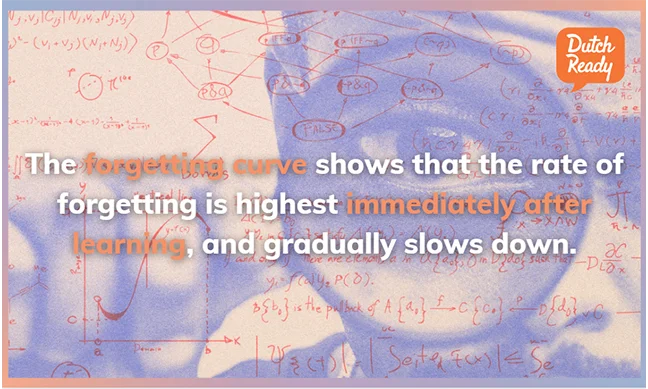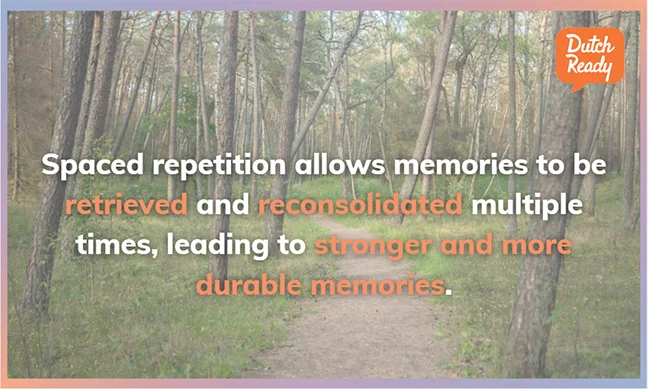

You’re putting in the hard work and have started studying vocabulary! Great job! But are you studying the smart way? Spaced repetition learning may be the key to finally making those new words stick. This learning technique, which involves reviewing new material at increasing intervals, has been shown to be highly effective for vocabulary acquisition. No wonder it’s at the basis of many modern language learning strategies. Let’s take a look at how it works.
Hermann Ebbinghaus was a German psychologist from the 1800s who is known for his work on the science of memory, specifically the concept of the forgetting curve. The forgetting curve is a graph that illustrates the decline in memory retention over time. Ebbinghaus observed that when information is not actively reviewed or used, it is quickly forgotten. His research showed that the rate of forgetting is highest immediately after learning, and gradually slows down over time. This concept has important implications for language learning, as it suggests that regular review and practice is necessary in order to maintain and improve language skills.
Since then, a whole host of studies have demonstrated the effectiveness of spaced repetition for language learning. For instance:

Image by rawpixel.com on Freepik
Recently, neuroscientific research has shed light on the underlying mechanisms behind the effectiveness of spaced repetition. One key aspect of this is the process of reconsolidation, which refers to the updating of memories during the retrieval process (Nader & Hardt, 2009). One important aspect of memory reconsolidation is its role in strengthening and stabilizing memories. When we first form a memory, it is fragile and prone to degradation. However, by accessing and reactivating that memory, we can strengthen it and make it more resistant to forgetting. This is especially important for language learning, as it allows us to retain new vocabulary and grammar structures over time.
Spaced repetition takes advantage of this process by strategically spacing out intervals between studying or reviewing material. This allows for the memory to be retrieved and reconsolidated multiple times, leading to stronger and more durable memories.
Spaced repetition learning algorithms are designed to optimize the intervals at which new material is reviewed in order to improve retention and memory. In other words, the algorithms try to make learning as efficient as possible. They typically work by trying to figure out your personal forgetting curve. By analyzing the curves, the algorithm can determine the optimal intervals for review based on your individual performance.

Image by wirestock on Freepik
Here is a detailed description of how a spaced repetition learning algorithm might work:
Now that you know one of the best ways to learn Dutch vocabulary, let us finally tell you which vocabulary is best to learn. This tip is especially applicable if you are a beginner learner. Dutch Ready has developed a free Core Vocab tool for you, which is a vocabulary list with the most frequently used words in our language. This way, you can immediately apply these words in your daily life.
Besides the Core Vocab, we also have the Easy Vocab tool for you: a tool packed with cognates and loanwords, meaning words of the same origin or adopted from another language. This also free tool is proof that you actually already have a much larger Dutch vocabulary than you think. Easy Vocab is available in Dutch-English, Dutch-French and Dutch-Spanish.
In conclusion, spaced repetition is a highly effective technique for vocabulary acquisition. By reviewing new words at increasing intervals, you can improve your retention and make those words stick in your long-term memory. Give spaced repetition a try and see the difference it can make in your vocabulary learning.
Rather have a personal teacher guide you? We can help there too. During our private lessons you can ask as many questions as you’d like, have lots of time to practice, and can focus on your own personal goals. Want to know more? You can read all about it here.
Scientific references in this article
We believe science-backed education is the future. Therefore we will always include links to the scientific research on which we base our methodology. The articles cited in this article are:
Cepeda, N. J., Pashler, H., Vul, E., Wixted, J. T., & Rohrer, D. (2006). Distributed practice in verbal recall tasks: A review and quantitative synthesis. Psychological Bulletin, 132(3), 354-380.
Ebbinghaus, H. (1885). Memory: A contribution to experimental psychology.
Freed, N. K., & Karpicke, J. D. (2016). Spaced repetition is the key to long-term retention. Journal of Experimental Psychology: Applied, 22(3), 366-378.
Nader, K., & Hardt, O. (2009). A single standard for memory: The case for reconsolidation. Nature Reviews Neuroscience, 10(3), 224-234. doi: 10.1038/nrn2560
Roediger, H. L., & Karpicke, J. D. (2006). The power of testing memory: Basic research and implications for educational practice. Perspectives on Psychological Science, 1(3), 181-210.
Want to learn Dutch fast? Check out our other blogs about effective language learning, like our article on picking the best Dutch words to learn first with Zipf’s Law, follow us on Instagram for mini lessons, or explore the Dutch language and culture with private Dutch lessons!
Language lessons & materials designed to help you learn Dutch fast. Use what you know, simplify what you don’t.

Hi! We just wanted to let you know that we use cookies on our site. These cookies enhance your experience, improve the quality of our site, and help us show you things that are more likely to be relevant to you. You have the option to manually allow third parties (including our advertising partners) to enable cookies on our website. By clicking 'Accept', you're agreeing to the placement and use of cookies described in our Cookie Policy. That's all. Thanks for reading!